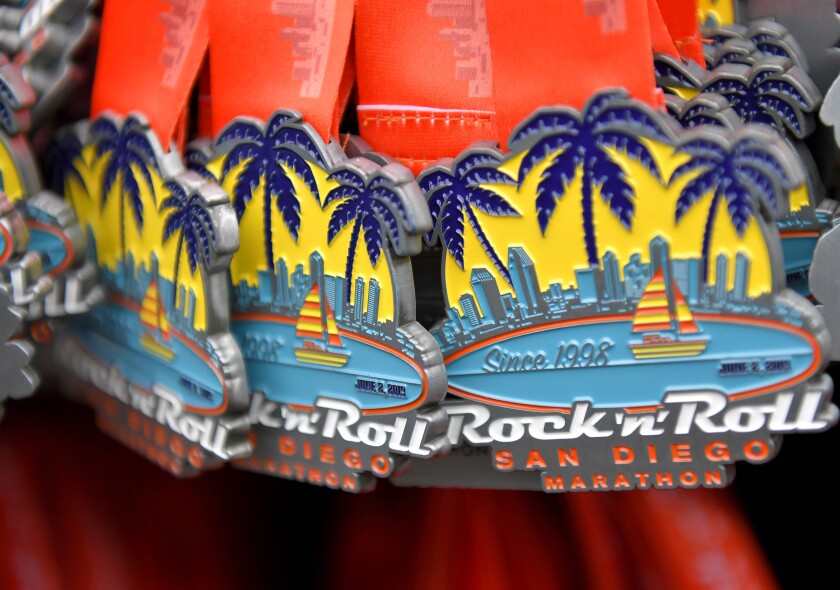Why smart runners will be thinking about elevation at the L.A. Marathon
The L.A. Marathon’s route is one Angelenos would never dream of driving.
On Sunday, more than 20,000 runners will line up at Dodger Stadium for the 26.2-mile race that will take them on a tour of the city unlike any other. They’ll bypass the freeways, following the region’s rolling surface streets past major landmarks in downtown, Hollywood, Beverly Hills and the Westside, until crossing the finish line by the Pacific Ocean.


Below is a breakdown of some of the course’s ups and downs, essential reading for both first-time marathoners and aspiring record-breakers. For non-runners: You can still use this guide to experience the race from the safety of your own device.
Elevation matters
Across 26.2 miles, you’re bound to encounter a hill or two. The L.A. course is no exception, with uphill sections that can present a surprise to unprepared runners.
Though elevation estimates vary across sources, the Los Angeles Times calculated a total elevation gain of about 950 feet. For contrast, the San Francisco Marathon climbs up 1,175 feet of hills as it loops around the city and across the Golden Gate Bridge.
Similar to Los Angeles, the Boston Marathon course generally runs downhill, with an infamous 95-foot climb at Mile 20 known as “Heartbreak Hill.”
Comparing marathon elevations

Boston

Los Angeles

San Francisco
Sean Hartnett, a geographer at University of Wisconsin-Eau Claire and a marathon writer for Track & Field News, has surveyed races across the U.S. and Europe, producing detailed elevation breakdowns for races in Boston, New York, Chicago, London and Berlin.
Though not accurate down to the step, elevation profile charts can help runners plan how to exert their energy over several hours, Hartnett said. Elite marathoners have used Hartnett’s data to help them break course and world records.
“In a marathon, you don’t like to be surprised,” he said. “The key thing is you get your head around it, plan for those hills.”
The ups and downs of L.A.
There are many ways to measure the effects of elevation on running pace, but here’s a simple way of looking at it: A 10-foot gain in elevation slows down a runner by 2.4 seconds, while a 10-foot drop can offer a 1.8-second boost, according to a rule by LetsRun.com training expert John Kellogg.
To measure the effect Los Angeles’ rolling terrain might have on marathon runners, the Los Angeles Times analyzed more than 9,000 finishing times from last year’s race.
In 2019, finishers completed the race in about 4 hours 30 minutes. When race times are adjusted to Kellogg’s calculations, the course’s 1,300-foot elevation loss was just enough to cancel out the effects of running uphill on the average finishing time.
The effects of elevation did, however, play out across individual five-kilometer (3.1-mile) segments of the race.
Ups and downs throughout the race, by 3-mile split
With this in mind, it’s more important to focus on your running effort than, say, the pace displayed on your fitness watch, said Mario Fraioli, a marathon coach for 16 years.
“The best advice I can give is not to get too tied to a specific split that you’re trying to hit,” said Fraioli, who coached eight athletes at the recent Olympic trials in Atlanta.
He adds: On hills, “slowing down a little bit is OK. If you’re able to do that without burning excess energy, you’ll be able to get the [time] back.”
The race begins with a slight climb out of Dodger Stadium, before runners coast into downtown L.A. But before the fifth mile, the race has two significant climbs on 1st Street approaching Walt Disney Concert Hall and on Temple Avenue between Grand Avenue and Edgeware Road.
Though the stretch through Hollywood is mostly easy rolling hills, there’s a stretch on Sunset Boulevard — starting at Mile 12 between La Brea and Fairfax avenues — known as a “false flat,” said Stacy Embretson, the director of operations for the L.A. Marathon. These areas of the race seem flat but feel grueling. “As if the wheels of the bike are coming off,” she said.
Watch out for another false flat at Mile 16 on Burton Way.
At Mile 20, runners must fight fatigue and the incline of Sepulveda Boulevard. By the three-mile split, runners experience the slowest times between Miles 21 and 24, peaking at an average pace of 11:47.
Relief is on the horizon at San Vicente Boulevard, with a downhill sprint to the finish line. Maintain a quick cadence, relax the upper body and stay upright to keep gravity from beating up on you, Fraioli said.
The moral of the story for race day: If you're aiming for a particular finishing time, give yourself a 10-15 second range on either side of your goal pace.
“In my experience,” Fraioli said, “that’s how you can ‘evenly’ pace yourself on a course like this.”
Race of fame
Not into this nerdy runner stuff? There’s more than one way to experience the race, most of them without actually running. While many metropolitan races pass by major landmarks, Los Angeles' marathon is a veritable run of fame. The Los Angeles Times’ Sam Farmer walked the route ahead of time to get a sense of the culture and history on display.
From
Dodger
Stadium
through
Chinatown
down
Spring
Street
to
the
first
uphill
climb.
You’ll
see
the
Walt
Disney
Concert
Hall

and
run
past
Echo
Park
Lake,
once
the
west
end
of
Los
Angeles.
After
rejoining
Sunset
Boulevard,
the
course
transitions
to
Hollywood
Boulevard
where
the
run
is
all
about
the
Walk.



Back
on
Sunset
Boulevard,
find
a
centerpiece
of
L.A.
history,
Chateau
Marmont
The
weird
energy
continues
on
Rodeo
Drive.

Continue
through
Century
City
past
the
monumental
Los
Angeles
California
Temple.

If
you
squint,
you'll
see
the
Getty
Center.
On
San
Vicente
Boulevard
the
home
stretch
begins
to
the
finish
line
at
the
sea.



